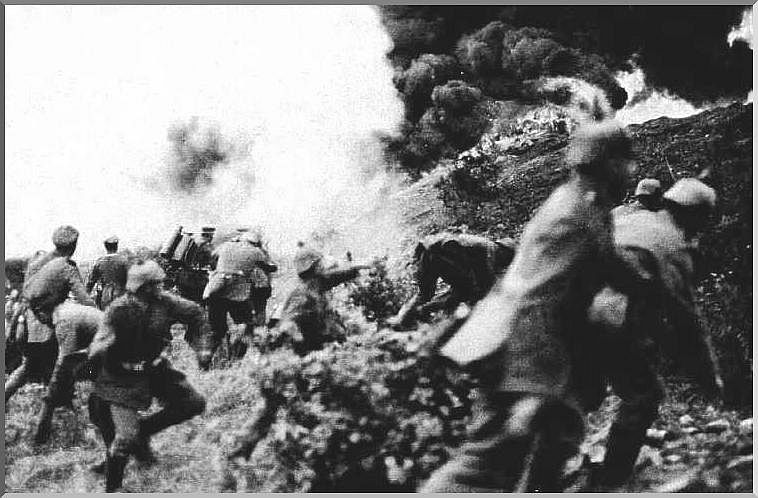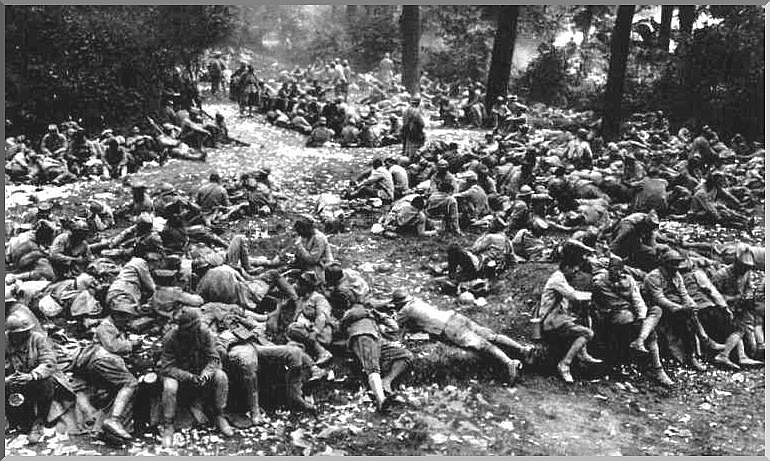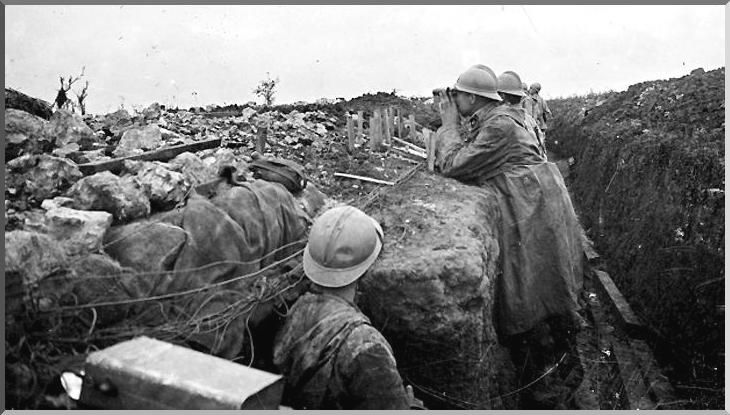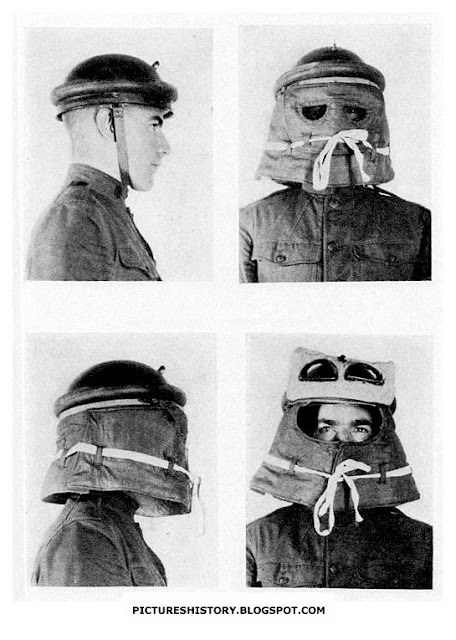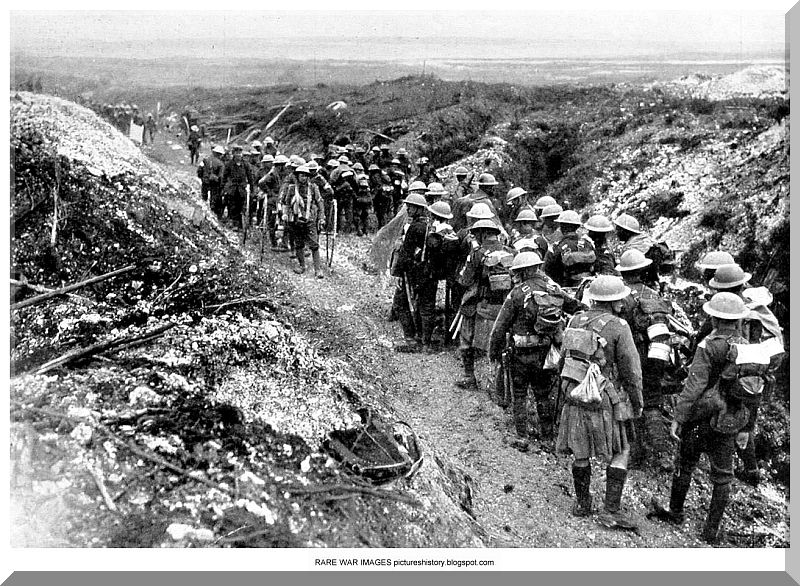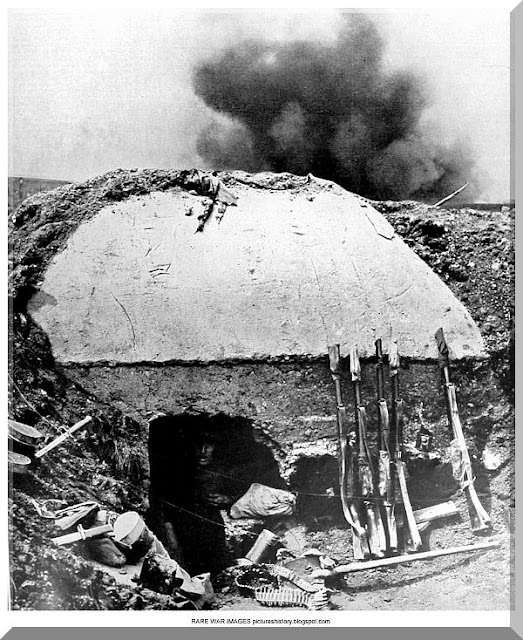World War I was an armed world conflict that took place mostly in Europe between 1914 and 1918 and it was fought by the Allies (Great Britain, France, Russia, and United States) on one side, and the Central Powers (Germany, Austria-Hungary, and the Ottoman Empire) on the other. The Allies were aligned under a common agreement known as the Triple Entente, and the Central Powers under the Triple Alliance. In World War I, or the Great War, new weapons such as the machine gun, the tank and improved artillery pieces made the use of the horse in the battle field irrelevant, causing the demise of the cavalry. Thus, this major military struggle is sometimes referred to as the first industrial war.
The machine gun gave the infantry a great volume of fire which caused a high number of casualties, forcing the armies to dig long systems of trenches and fortifications that ran for hundreds of miles, from the North Sea to the border of Switzerland. The space between two opposing systems of trenches was known as "no man’s land." During World War I airplanes were used for the first time, but they were limited to dogfight aerial combats and reconnaissance flights. Armored battleships and submarines were also used in naval theaters of operations.
Map of Europe in 1914
Causes of World War IThe Armed Peace. The Armed Peace is the period between the German unification right after the Franco-Prussian War of 1871, and the beginning of World War I. It is a period characterized by an arms race among Great Britain, France, Germany, and Austria, and a series of diplomatic crises which increased the tension between nations of these opposing groups. The two important crises were the Moroccan Crises between France and Germany in which the latter country attempted to prevent French annexation of Morocco, and the Austrian annexation of Bosnia and Herzegovina.
System of Alliances. Although the roots of the Great War strike deeply into European history, one can get a fairly definite idea of its origin by beginning with the system of agreements that divided Europe into two armed camps before 1914. The German Chancellor Otto Bismarck virtually created the Triple Alliance in 1882, when he bound Germany, Austria, and Italy together in treaties that provided military cooperation in case of attack by France and Russia. In 1904, laying aside existing differences, England and France formed the Entente Cordiale, in which France recognized British primacy in Egypt in return for a British recognition of French interests in Morocco. This defensive agreement included Russia in 1907, forming thus what is known in history as the Triple Entente.
The Assassination of Archiduke Francis Ferdinand. The immediate cause of World War I was the murder of Archiduke Francis Ferdinand, the Austrian heir-apparent to the throne by Gavrilo Princip, a Bosnian Serb, on June 28, 1914, in Sarajevo. The Archduke was there to assert imperial authority over a disputed province. The assassination sparked the chain of events that led straight to military hostilities. As it was shown that Serbian officials knew of the impending assassination, the Austrian government sent Serbia an ultimatum which, among other things, demanded that Austrian officials be allowed to aid in the suppression of all hostile activities in the disaffected regions. The reply being unsatisfactory, an Austrian declaration of war followed on July 28, 1914.
Gavrilo Princip being arrested after having murdered Francis Ferdinand
Outbreak of HostilitiesRussia supported Serbia, and Germany favored Austria. After receiving unsatisfactory replies to ultimata that she had sent both Russia and France, Germany declared war on both on August 1, 1914. The English Foreign Minister, Lord Grey, endeavored to prevent a war through a conference of the powers, but he failed to indicate clearly what England would do if war should occur. Even after the conflict began, England remained out until the German army violated Belgian neutrality by invading Belgium on August 4. Therupon England declared war on Germany on the same day. Allied to both Germany and Austria-Hungary, Italy was able to avoid entering the war by citing a clause enabling it to evade its obligations to both.
Devised by former army Chief of Staff Alfred von Schlieffen, the Schlieffen Plan had been conceived to deal with a two-front war scenario. The outlined plan was to conquer France, knocking her out the war, on a wester front within five weeks, before Russia could effectively mobilize for war on an eastern front. But the German plan did not take into account of England’s entry into the war. So, following the Schlieffen Plan, Germany invaded Belgium on August 4, 1914, to strike France from the north on weak points. Thus, the Battle of Liege ensued. It lasted twelve days, from August 5 until August 16, 1914. It was the first land battle of the war.
At the beginning the German forces had great success, but Russia attacked in East Prussia and diverted German forces intended for the Western Front. Germany defeated Russia in a series of battles collectively known as the Battle of Tannenberg fought between August 17 and September 2. This diversion created problems of insufficient speed of advance from rail-heads; this had not been foreseen by the German General Staff, as the Schlieffen Plan originally called for the right flank of the German advance to pass to the west of Paris. However, the capacity and low speed of horse-drawn transport hampered the German supply train, allowing French and British forces to finally halt the German advance east of Paris at the First Battle of the Marne that took place between September 5 and September 12, 1914.
African Campaign. Some of the first hostilities of war occurred in Africa, in the colonies and territories of the European nations. On August 8, 1914, combined French and British forces invaded the German protectorate of Togoland in West Africa. Shortly thereafter, on August 10, German troops based in South-West Africa attacked South Africa, which was part of the British Empire.
Serbian Campaign. The Austrian Army invaded Serbia in August, 1914, and fought the Battle of Cer against the Serbian forces, which threw back the enemy attacks over the next two week with the Austrians taking heavy losses. This dashed Austrian hopes of a swift victory. As a result, Austria had to keep sizable forces on the Serbian front, weakening their efforts against Russia.
The Pacific. Another British Dominion, New Zealand, occupied German Samoa on August 30, 1914. On September 11 Australian Naval and Military Expeditionary Force landed on the island of Neu Pommern, which was part of German New Guinea.
Trench WarfareAfter the First Battle of the Marne, both Entente and German forces began a series of outflanking maneuvers, in the so-called race to the sea. Great Britain and France soon found themselves facing entrenched German forces from Lorraine to Belgium’s Flemish coast. British and French forces sought to take the offensive, while Germany defended the occupied territories. As a result, German trenches were generally much better constructed than those of their enemy. Anglo-French trenches were only intended to be temporary before their forces broke through German defenses. Both sides attempted to break the stalemate using scientific and technological advances. In April 1915 the Germans used chlorine gas for the first time, opening a 6-kilometer gap in the Allied lines when British and French colonial troops retreated. Canadian soldiers closed the breach at the Second Battle of Ypres. At the Third Battle of Ypres, Canadian and ANZAC troops took the village of Passchendaele.
On July 1, 1916, the Battle of the Somme began. The British Army endured the bloodiest day in its history, suffering 19,240 dead and around 30,000 wounded. Most of the casualties occurred in the first hour of the attack. The entire offensive cost the British Army almost half a million men, as neither side proved able to deliver a decisive blow for the next two years.
Protracted German action at the Battle of Verdun throughout 1916, combined with the Entente’s failure at the Somme, brought the exhausted French army to the brink of collapse. Futile attempts at frontal assault, a rigid adherence to an ineffectual method, came at a high price for both the British and the French infantry and led to widespread mutinies, especially during the Nivelle Offensive.
Between 1915 and 1917 the British and the French suffered more casualties thant the Germans due both to the strategic and tactical stances chosen by the sides. At the strategic level, while the Germans only mounted a single main offensive at Verdun, the Allies made several attempts to break through German lines. At the tactical level, the German defensive doctrine was well suited for trench warfare, with a relatively lightly defended sacrificial forward position, and a more powerful main position from which an immediate and powerful counter-offensive could be launched. In the 1917 Battle of Arras the only significant British military success was the capture of Vimy Ridge by the Canadian Corps under Sir Arthur Currie and Julian Byng. The assaulting troops were able for the first time to overrun, rapidly reinforce and hold the ridge defending the coal-rich Douai plain.
Naval WarfareSoon after the outbreak of hostilities, Great Britain started a naval blockade of Germany. The strategy proved effective, cutting off vital military and civilian supplies, although this blockade violated generally accepted international law codified by several international agreements of the past two centuries. Britain mined international waters to prevent any ships from entering entire sections of ocean, causing danger to even neutral ships. In 1916, the Battle of Jutland took place in the North Sea off the coast of Jutland. It was the largest naval battle of the war and the only full-scale clash of battleships during the whole conflict. The Kaiserliche Marine’s High Seas Fleet, commanded by Vice Admiral Reinhard Scheer, squared off against the Royal Navy’s Grand Fleet, led by Admiral Sir John Jellicoe. The engagement was a standoff, as the Germans, outmaneuvered by the larger British fleet, managed to escape and inflicted more damage to the British fleet than they received.
Meanwhile German U-boats endeavored to cut the supply lines between North America and Great Britain. The nature of submarine warfare meant that attacks often came without warning, giving the crews of the merchant ships little hope of survival. The United States launched a protest, and Germany modified its rules of engagement. After the infamous sinking of the passenger ship RMS Lusitania in 1915, Germany promised not to target passenger liners, while Britain armed its merchant ships. But early in 1917 Germany adopted a policy of unrestricted submarine warfare, realizing the Americans would eventually enter the war. Germany sought to choke Allied sea lanes before the U.S. could transport a large army overseas.
Gallipolli
By 1915 the Western Front was clearly a bloody stalemate. Allied strategy was under scrutiny, with strong arguments mounted for an offensive through the Balkans or even a landing on Germany’s Baltic coast, instead of more costly attacks in France and Belgium. These ideas were at the beginning sidelined, but in early 1915, as the Russians found themselves threatened by the Turks in the Caucasus, the British decided to mount a naval expedition to bomb and take the Gallipoli Peninsula on the western shore of the Dardanelles, with Constantinople as its objective. By capturing Constantinople, the British hoped to link up with the Russians, knock Turkey out of the war and possibly persuade the Balkan states to join the Allies.
Although naval attack began on February 19, bad weather conditions caused delays as the attack was abandoned after three battleships had been sunk and three others damaged. Military assistance was required, but by the time troops began to land on April 25, the Turks had prepared adequate fortifications and the defending armies were now six times larger than when the campaign began. Nevertheless, against determined opposition, Australian and New Zealand troops managed to win a bridgehead at Anzac Cove on the Aegean side of the peninsula. The British, meanwhile, tried to land at five points around Cape Helles, but established footholds in only three before asking for reinforcements. Thereafter little progress was made, and the Turks took advantage of the British halt to bring as many troops as possible onto the peninsula. This led to a standstill which dragged on with heavy casualties. After a political crises in London over Gallipoli, the whole operation was cancelled and the troops were withdrawn from the area.
Italian Envolvement
Italy had been tied to the Triple Alliance with Germany and Austria-Hungary since 1982. But as the country had its own interest on Austrian territory in Trentino, Istria, and Dalmatia, Italy had signed a secret pact with France in 1902, thus nullifying its alliance with the former nations. Encouraged by the Allied invasion of Turkey in April 1915, Italy joined the Entente and declared war on Austria-Hungary in May. Fifteen months later, it declared war on Germany.
Although Italy had numerical superiority, this advantage was lost, not only because of the difficult terrain in which fighting took place, but also because of the strategies and tactics employed. Field Marshal Luigi Cadorna, a staunch proponent of the frontal assault, wanted to break into the Slovenian plateau, take Ljubljana, and threaten Vienna. It was a Napoleonic plan, which had no realistic chance of success in an age of barbed wire, machine guns, and indirect artillery fire, combined with hilly and mountainous terrain.
Eleven offensives were ordered by General Luigi Cadorna north-east of Trieste along the Isonzo River, with total disregard for his men’s lives. All eleven offensives were repelled by the Austro-Hungarians who held the higher ground. In the summer of 1916, the Italians captured the town of Gorizia. After this minor victory, the front remained static for over a year, despite several Italian offensives. In the autumn of 1917, thanks to the improving situation on the Eastern front, the Austrians received large numbers of reinforcements, including German Stormtroopers and the elite Alpenkorps. The Central Powers launched a crushing offensive on October 26, 1917, spearheaded by the Germans, attaining a victory at Caporetto.
But the Austro-Hungarians failed to break through in a series of battles on the Asiago Plateau. The front stabalize for a while, then the Italian finally and decisively defeated the Central Powers forces at the Battle of Vittorio Veneto in October of that year. Austria-Hungary surrendered in early November 1918.
Eastern FrontAs the Western Front reached stalemate, the war still went on in the East. Initial Russian plans called for simultaneous invasions of Austrian Galicia and German East Prussia. Russia’s initial advance into Galicia was largely successful, but they were thrown back from East Prussia by Hindenburg and Ludendorff at Tannenberg and the Masurian Lakes in August and September 1914. Russia’s less developed industrial base and ineffective military leadership was instrumental in the events that unfolded. By the spring of 1915, the Russians had retreated into Galicia, and in May the Central Powers achieved a remarkable breakthrough on Poland’s southern frontiers. On August 5 they captured Warsaw and forced the Russians to withdraw from Poland. This became known as the "Great Retreat" in Russia and the "Great Advance" in Germany.
In June 1916, there was a successful Russian offensive in eastern Galicia. However, dissatisfaction with the Russian government’s conduct of the war grew. There was reluctance of some Russian generals to commit their forces to support the victory. In March 1917, demonstrations in Petrograd culminated in the abdication of Tsar Nicholas II and the appointment of a weak Provisional Government which shared power with the Petrograd Soviet socialists. This arrangement led to confusion and chaos both at the front and at home, as the army became increasingly ineffective.
The Russian government became more and more unpopular as discontent led to a rise in popularity of the Bolshevik party, led by Vladimir Lenin who promised to pull Russia out of the war and was able to gain power. The triumph of the Bolsheviks in November was followed in December by an armistice and negotiations with Germany. The Treaty of Brest-Litovsk, signed on March 3, 1918, took Russia out of the war and ceded vast territories, including Finland, the Baltic provinces, parts of Poland and Ukraine to the Central Powers. This allowed Germany to ship troops from the Eastern Front to the Western Front.
United States Entry Into The WarAmerica’s long standing policy of isolationism left the United States reluctant to get involved with what was popularly perceived among the American people as a European war. But, in 1915, 128 American citizens died when a German U-boat sank the British liner Lusitania; President Woodrow Wilson demanded an ends to attacks on passenger ships. But in January 1917 Germany resumed its policy of unrestricted submarine warfare.
Early in February 1917, the Britishsecret Royal Navy cryptanalytic group, Room 40, broke the German diplomatic code. They intercepted a proposal from Berlin to Mexico to join the war as Germany’s ally against the United States, should the U.S. join. The proposal suggested, if the U.S. were to enter the war, Mexico should declare war on the United States and enlist Japan as an ally. The American press published it on March 1, 1917, and stirred up public indignation. This German secret message, known as the Zimmermann Telegram, plus the unrestricted submarine warfare led to a final break of relations with the Central Powers. After further U-boat attacks on American merchant ships, President Woodrow Wilson finally requested that Congress declare war on Germany. The American Congress declared war on April 6, 1917.
German Spring Offensive of 1918German General Erick Luderndorff devised plans for a major attack that took place in the Spring of 1918 on the Western Front. This Spring Offensive attempted to divide the British and French armies in a series of maneuvers, assaults on fortifications, and advances. Kaiserschlacht was the German name for the the Spring Offensive, in which there were three separate German attacks, codenamed Michael, Georgette and Blucher-Yorck. The operation began on March 21, 1918 with an attack on British forces near Amiens. The German army advanced 60 kilometers on this first attack.
By this stage of the war, Germany had refined its tactics and developed stormtroopers to infiltrate and bypass enemy front line units, leaving these strong points to be attacked by follow-up waves of friendly infantry troops. The stormtroopers’ objective was to assault and disrupt enemy headquarters, artillery units and supply depots in the rear areas, as well as to rapidly occupy territory. This new infiltration strategy was called Hutier tactics, after General Oskar von Hutier.
The front advanced to within 120 kilometers of Paris. Three heavy Krupp railway guns fired 183 shells on the capital, causing many Parisians to flee. The initial offensive was so successful that Kaiser Wilhelm II declared March 24 a national holiday. Many Germans thought victory was near. After heavy fighting, however, the offensive was halted. Lacking tanks or motorized artillery, the Germans were unable to consolidate their gains. The sudden stop was also a result of the four Australian Imperial divisions that were rushed down to the front, thus doing what no other army had done, stopping the German advance in its tracks. During that time the first Australian division was hurriedly sent north again to stop the second German breakthrough.
Following Operation Michael, Germany launched Operation Georgette against the northern channel ports held by the English. The Allies halted the drive with limited territorial gains for Germany. The German Army to the south then conducted Operations Blücher and Yorck, broadly towards Paris. Operation Marne was launched on July 15, attempting to encircle Reims and beginning the Second Battle of the Marne. The resulting Allied counterattack marked their first successful offensive of the war.
By July 20 the Germans were back at their Kaiserschlacht starting lines. Following this last phase of the war in the West, the German Army never again regained the initiative. German casualties between March and April 1918 were 270,000, including many highly trained stormtroopers. Meanwhile, Germany was falling apart at home. Anti-war marches become frequent as morale in the army fell. Industrial output was at 53% of the 1913 levels. German reserves were inadequate and the German High Command advised their government to give up the war.
Allied VictoryAllied counteroffensive, known as the Hundred Days Offensive, began on August 8, 1918. The Battle of Amiens developed with the Fourth British Army on the left, the First French Army on the right, and the Australian and Canadian Corps spearheading the offensive in the centre through Harbonnieres. 414 tanks of the Mark IV and Mark V type, and 120,000 men were involved in the Battle of Amiens, which signaled the beginning of Germany’s downfall. September saw the Germans continuing to fight strong rear guard actions and launching numerous counter attacks on lost positions. However, towns, villages, heights, trenches, and outposts of the Hindenburg Line continued to fall to the Allies.
The Allied attack on the Hindenburg Line began on September 26, 1918, with 260,000 Americans participating in the military operations. French units broke through in Champagne and closed on the Belgian border. By October, it was evident that Germany could no longer mount a successful defence as they were increasingly outnumbered, with few new recruits. Rations were cut.
Having suffered over 4 million casualties, Germany moved toward peace. Prince Max von Baden took charge of a new government as Chancellor of Germany to negotiate with the Allies. Negotiations with President Wilson began immediately, in the vain hope that better terms would be offered than with the British and French. Instead Wilson demanded the resignation of the Kaiser, who had just abdicated and fled to Holland on November 9, 1918. A republic would be proclaimed in Germany, the Weimar Republic.
The fighting in World War I ended when an armistice took effect at 11:00 hours on November 11, 1918. This armistice treaty between the Allies and Germany was signed in a railway carriage in woods near Compiègne on November 11, 1918, and marked the end of the First World War on the Western Front. Principal signatories were Marshal Ferdinand Foch, Allied Commander-in-chief, and Matthias Erzberger, a representative of the closest thing left that Germany had as a government.
Treaty of VersaillesThe Treaty of Versailles ended the state of war between Germany and the Allied Powers. It was signed on 28 June 1919, exactly five years after the assassination of Archduke Francis Ferdinand, one of the events that had triggered the start of the war. Although the armistice signed on 11 November 1918 ended the actual fighting, it took six months of negotiations at the Paris Peace Conference to conclude the peace treaty. Of the many provisions in the treaty, one of the most important and controversial required Germany and its allies to accept full responsibility for causing the war and, under the terms of articles 231-248, to disarm, make substantial territorial concessions and pay reparations to certain countries that had formed the Entente powers.
The Treaty of Versailles was a lengthy document, which was a punitive instrument of peace imposed by the victors, and pertained solely to Germany. To complete the settlement officially ending the war a separate treaty was framed for each of the nations that along with Germany had constituted the Central Powers.
The treaty compelled Germany to assume the responsability of having caused the war. By its provisions Germany was committed to 1) surrender Alsace and Lorraine to France and German border areas to three other surrounding nations; 2) transfer all of its colonies to a mandate system under which they would administered by various Allied powers; 3) reduce its army to 100,000 men; 4) relinquish all warships of substantial size, all military planes, and all heavy guns; 5) make reparations for the entire cost of the war, which was subsequently fixed at approximately $56.5 billion.
Furious protests by German leaders over the treaty provisions brought no modification in them, and on June 28, 1919, representative from Germany in a sullen mood signed the document.
Text Source VIDEO















